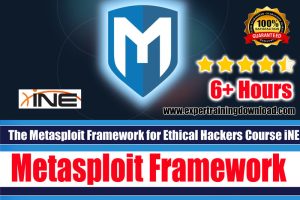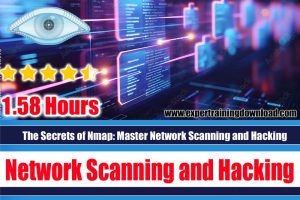Description
Price: 10.00 USD | Size: 5.41 GB | Duration : 16.4 Hours | Recorded 2 days Live Class | Bonus : bug bounty PDF Guides
BRAND: Expert TRAINING | ENGLISH | INSTANT DOWNLOAD | 
Full syllabus:
Day 1 – Recon
Recon Part 1: Recon Concepts
- Introduction to Recon
Recon Part 2: Acquisitions and Domains
- Scope
- Shodan
- ASN Analysis
- Crunchbase ++
- ReconGTP
- Reverse WHOIS
- Certificate Analysis
- Add and Analytics Relationships
- Supply chain investigation and SaaS
- Google-fu (trademark & Priv Pol)
- TLDs Scanning
- 0365 Enumeration for Apex Domains
Recon Part 3: Subdomain Enumeration
- Subdomain Scraping (all the best sources and why to use them)
- Security Trails + Netlas
- Brute force
- Wildcards
- Permutation Scanning
- Linked Discovery
- Wordlists
- Advantageous Subs (WAF bypass – Origins)
- Favicon analysis
- Sub sub domains
- Esoteric techniques
- Dnssec / nsec / nsec3 walking
Recon Part 4: Server & App Level Analysis
- Port Scanning
- Service Bruteforce
- Tech Stack
- Screenshotting
Recon Part 5: Profiling People for Social Engineering
- Linkedin (people, tech)
- Hunter.io
- Hiring Sites
Recon Part 6: Recon Adjacent Vulnerability Analysis
- CVE scanners vs Dynamic Analysis
- Subtakover
- S3 buckets
- Quick Hits (swagger, .git, configs, panel analysis)
Recon Part 7: Recon Frameworks and Helpers
- Frameworks
- Understanding your framework
- Tips for success (keys)
- Distribution and Stealth
Day 2 – Application Analysis
Application Analysis Part 1: Analysis Concepts
- Indented usage (not holistic, contextual)
- Analysis Layers
- Application Layers as related to success.
- Tech profiling
- The Big Questions
- Change monitoring
Application Analysis Part 2: Vulnerability Automation
- More on CVE and Dynamic Scanners
- Dependencies
- Early running so you can focus on manual.
- Secrets of automation kings
Application Analysis Part 3: Content Discovery
- Intro to CD (walking, brute/fuzz, historical, JS, spider, mobile, params)
- Importance of walking the app
- Bruteforce Tooling
- Bruteforce Tooling Lists: based on tech
- Bruteforce Tooling Lists: make your own (from-install, dockerhub, trials, from word analysis)
- Bruteforce Tooling Lists: generic/big
- Bruteforce Tooling Lists: quick configs
- Bruteforce Tooling Lists: API
- Bruteforce Tooling Tips: Recursion
- Bruteforce Tooling Tips: sub as path
- Bruteforce Tooling Tips: 403 bypass
- Historical Content Discovery
- Newschool JavaScript Analysis
- Spidering
- Mobile Content Discovery
- Parameter Content Discovery
Application Analysis Part 4: The Big Questions
- How does the app pass data?
- How/where does the app talk about users?
- Does the site have multi-tenancy or user levels?
- Does the site have a unique threat model?
- Abuse Primitives
- Has there been past security research & vulns?
- How does the app handle common vuln classes?
- Where does the app store data?
Application Analysis Part 5: Application Heat Mapping
- Common Issue Place: Upload functions
- Common Issue Place: Content type multipart-form
- Common Issue Place: Content type XML / JSON
- Common Issue Place: Account section and integrations
- Common Issue Place: Errors
- Common Issue Place: Paths/URLs passed in parameters
- Common Issues Place: chatbots
Application Analysis Part 6: Web Fuzzing & Analyzing Fuzzing Results
- Parameters and Paths (generic fuzzing)
- Reducing Similar URLs
- Dynamic only fuzzing
- Fuzzing resources SSWLR – “Sensitive Secrets Were Leaked Recently”
- Backslash powered Scanner
Application Analysis Part 7: Introduction to Vulnerability Types
- Indented usage (not holistic. Tips and Contextual)
- Covered vulns and why
Application Analysis Part 8: XSS Tips and Tricks
- Stored and Reflected
- Polyglots
- Blind
- DOM
- Common Parameters
- Automation and Tools
Application Analysis Part 9: IDOR Tips and Tricks
- IDOR, Access, Authorization, MLAC, Direct browsing Business logic, parameter manipulation
- Numeric IDOR
- Identifying user tokens GUID IDOR
- Common Parameters
Application Analysis Part 10: SSRF Tips and Tricks
- SSRF intro
- schemas
- Alternate IP encoding
- Common Parameters
Discover more from Expert Training
Subscribe to get the latest posts sent to your email.























Reviews
There are no reviews yet.